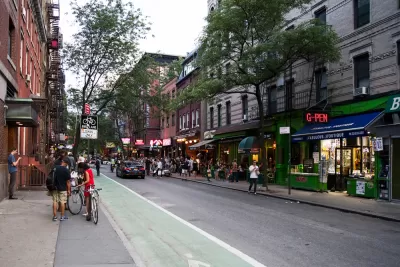Although individual old buildings may be less expensive than newer ones nearby, historic preservation may make both old and new buildings more expensive.

I was having an online chat about historic preservation in a listserv, and someone argued that an undistinguished-looking 1930s building should be treated as a historic landmark in order to prevent a new building from being erected there. If I understood him correctly, my acquaintance reasoned that old buildings tended to be cheaper, and thus their presence would protect neighborhood diversity. In the words of Jane Jacobs: "Cities need old buildings so badly it is probably impossible for vigorous streets and districts to grow without them…If a city area has only new buildings, the enterprises that can exist there are automatically limited to those that can support the high costs of new construction."
There is only one problem with my acquaintance's argument: the building in question was located in Manhattan's West Village. To a greater extent than any other Manhattan neighborhood, the West Village has been "protected" from new housing by historic landmark laws. 70 percent of all properties in the West Village are historic landmarks, and thus are more difficult than other land to redevelop. As a result, almost all housing in this neighborhood is prewar (that is, built before 1945): I did a search on Streeteasy.com for one-bedroom apartments in the West Village, and 84 out of 100 apartments listed were prewar. By contrast, in the slightly more affluent Upper East Side, there are almost as many postwar one-bedrooms as prewar (254 prewar, 237 postwar).* So if old buildings were always more affordable, the West Village would be less expensive than other Manhattan neighborhoods.
But this is not the case. Admittedly, the West Village’s older units are cheaper than its newer ones: 21 percent (18 of 84) prewar units rented for under $3000, while none of the postwar units were that cheap. 46 of the 84 prewar units rented for under $4000, as opposed to only one of the postwar units.
However, the West Village's older units are much more expensive than other neighborhoods' older units, and the West Village's newer units are much more expensive than other neighborhoods' newer units. For example, let's compare the West Village with the Upper East Side. The cheapest one-bedroom in the West Village rented for $2495; a slight majority (132 out of 255) prewar units in the Upper East Side rented for less than that. Over 70 percent (185 out of 255) prewars in the Upper East Side rented for under $3000, as opposed to 21 percent of those in the West Village. Postwar apartments are also less expensive in the Upper East Side; over 70 percent of Upper East Side postwar units rented for under $4000 (169 out of 226), as opposed to only 6 percent of postwar West Village one-bedrooms (1 out of 16).
Admittedly, the Upper East Side might be an aberration, since its subway connections are not quite as strong as those of other Manhattan neighborhoods. But both prewar and postwar apartments are cheaper in a wide variety of other neighborhoods than in the West Village.
For example, in the Upper West Side, which has excellent subway connections, almost 60 percent percent (161 out of 274) of prewar one-bedrooms rented for under $3000; in Hell's Kitchen just to the south, 78 percent of prewars (56 of 71) rent for under $3000. In my own Murray Hill, a part of midtown which is historically wealthier than Hell's Kitchen, 12 of 32 prewars rented for under $3000—a smaller percentage than in the other areas I mentioned, but still more than in the West Village.
Postwar apartments are also cheaper in other areas with more of them. In the Upper West Side, a slight majority (97 of 188) of postwar one-bedrooms rent for under $4000. Similarly, in Hell's Kitchen, 62 percent (86 of 137) of its postwar one-bedrooms rent for under $4000. My own Murray Hill is a little more expensive: 35 out of 81 postwar one-bedrooms rent for under $4000. In other words, nearly every uptown Manhattan neighborhood seems to have cheaper prewar units and cheaper postwar units than the West Village. Obviously, its uniquely high levels of historic preservation have failed to make the neighborhood more affordable.
Why? One possible interpretation, of course, is that the West Village would be equally desirable and expensive even if it was dominated by new buildings; I do not see why this should be the case, but am open to suggestions. Another possible interpretation is that its historic preservation actually increases property values by creating an amenity that people will pay extra for and thus increasing demand for West Village apartments. And because this policy also reduces the supply of postwar apartments, it may also raises the price of such apartments. If this hypothesis is correct, New York's vigorous historic preservation policy may actually make the West Village's old buildings more expensive than they would otherwise be.
*Because Streeteasy.com listings change daily, your results may of course vary.

Trump Administration Could Effectively End Housing Voucher Program
Federal officials are eyeing major cuts to the Section 8 program that helps millions of low-income households pay rent.

Planetizen Federal Action Tracker
A weekly monitor of how Trump’s orders and actions are impacting planners and planning in America.

Ken Jennings Launches Transit Web Series
The Jeopardy champ wants you to ride public transit.

Washington Legislature Passes Rent Increase Cap
A bill that caps rent increases at 7 percent plus inflation is headed to the governor’s desk.

From Planning to Action: How LA County Is Rethinking Climate Resilience
Chief Sustainability Officer Rita Kampalath outlines the County’s shift from planning to implementation in its climate resilience efforts, emphasizing cross-departmental coordination, updated recovery strategies, and the need for flexible funding.

New Mexico Aging Department Commits to Helping Seniors Age ‘In Place’ and ‘Autonomously’ in New Draft Plan
As New Mexico’s population of seniors continues to grow, the state’s aging department is proposing expanded initiatives to help seniors maintain their autonomy while also supporting family caregivers.
Urban Design for Planners 1: Software Tools
This six-course series explores essential urban design concepts using open source software and equips planners with the tools they need to participate fully in the urban design process.
Planning for Universal Design
Learn the tools for implementing Universal Design in planning regulations.
Heyer Gruel & Associates PA
Ada County Highway District
Institute for Housing and Urban Development Studies (IHS)
City of Grandview
Harvard GSD Executive Education
Toledo-Lucas County Plan Commissions
Salt Lake City
NYU Wagner Graduate School of Public Service






























